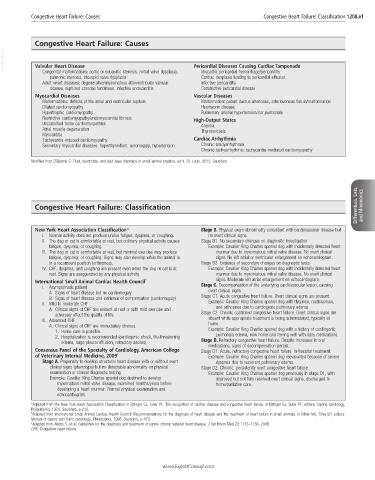Page 2440 - Cote clinical veterinary advisor dogs and cats 4th
P. 2440
Congestive Heart Failure: Causes Congestive Heart Failure: Classification 1208.e1
Congestive Heart Failure: Causes
VetBooks.ir Valvular Heart Disease Pericardial Diseases Causing Cardiac Tamponade
Congenital malformations: aortic or subaortic stenosis, mitral valve dysplasia,
Cardiac neoplasia leading to pericardial effusion
pulmonic stenosis, tricuspid valve dysplasia Idiopathic pericardial hemorrhage/pericarditis
Adult-onset diseases: degenerative/myxomatous atrioventricular valvular Infective pericarditis
disease, ruptured chordae tendineae, infective endocarditis Constrictive pericardial disease
Myocardial Diseases Vascular Diseases
Malformations: defects of the atrial and ventricular septum Malformation: patent ductus arteriosus, arteriovenous fistula/malformation
Dilated cardiomyopathy Heartworm disease
Hypertrophic cardiomyopathy Pulmonary arterial hypertension/cor pulmonale
Restrictive cardiomyopathy/endomyocardial fibrosis High-Output States
Unclassified feline cardiomyopathies Anemia
Atrial muscle degeneration Thyrotoxicosis
Myocarditis
Tachycardia-induced cardiomyopathy Cardiac Arrhythmia
Secondary myocardial diseases: hyperthyroidism, acromegaly, hypertension Chronic bradyarrhythmia
Chronic tachyarrhythmia: tachycardia-mediated cardiomyopathy
Modified from DiBartola S: Fluid, electrolyte, and acid-base disorders in small animal practice, ed 4, St. Louis, 2012, Saunders.
Differentials, Lists, and Mnemonics
Congestive Heart Failure: Classification
New York Heart Association Classification* Stage B. Physical exam abnormality consistent with cardiovascular disease but
I. Normal activity does not produce undue fatigue, dyspnea, or coughing. no overt clinical signs.
II. The dog or cat is comfortable at rest, but ordinary physical activity causes Stage B1. No secondary changes on diagnostic investigation
fatigue, dyspnea, or coughing. Example: Cavalier King Charles spaniel dog with incidentally detected heart
III. The dog or cat is comfortable at rest, but minimal exercise may produce murmur due to myxomatous mitral valve disease. No overt clinical
fatigue, dyspnea, or coughing. Signs may also develop while the animal is signs. No left atrial or ventricular enlargement on echocardiogram.
in a recumbent position (orthopnea). Stage B2. Evidence of secondary changes on diagnostic tests.
IV. CHF, dyspnea, and coughing are present even when the dog or cat is at Example: Cavalier King Charles spaniel dog with incidentally detected heart
rest. Signs are exaggerated by any physical activity. murmur due to myxomatous mitral valve disease. No overt clinical
International Small Animal Cardiac Health Council † signs. Moderate left atrial enlargement on echocardiogram.
I. Asymptomatic patient Stage C. Decompensation of the underlying cardiovascular lesion, causing
A. Signs of heart disease but no cardiomegaly overt clinical signs
B. Signs of heart disease and evidence of compensation (cardiomegaly) Stage C1. Acute congestive heart failure. Overt clinical signs are present.
II. Mild to moderate CHF Example: Cavalier King Charles spaniel dog with dyspnea, restlessness,
A. Clinical signs of CHF are evident at rest or with mild exercise and and orthopnea due to cardiogenic pulmonary edema
adversely affect the quality of life. Stage C2. Chronic controlled congestive heart failure. Overt clinical signs are
III. Advanced CHF absent while appropriate treatment is being administered, typically at
A. Clinical signs of CHF are immediately obvious. home.
1. Home care is possible. Example: Cavalier King Charles spaniel dog with a history of cardiogenic
2. Hospitalization is recommended (cardiogenic shock, life-threatening pulmonary edema, now home and feeling well with daily medications.
edema, large pleural effusion, refractory ascites). Stage D. Refractory congestive heart failure. Despite increases in oral
medications, signs of decompensation persist.
Consensus Panel of the Specialty of Cardiology, American College Stage D1. Acute, refractory congestive heart failure. In-hospital treatment.
of Veterinary Internal Medicine, 2009 ‡ Example: Cavalier King Charles spaniel dog reevaluated because of severe
Stage A. Propensity to develop structural heart disease with or without overt dyspnea due to recurrent pulmonary edema.
clinical signs (phenotype) but no detectable abnormality on physical Stage D2. Chronic, persistently overt congestive heart failure.
examination or clinical diagnostic testing. Example: Cavalier King Charles spaniel dog previously in stage D1, with
Example: Cavalier King Charles spaniel dog destined to develop improved but not fully resolved overt clinical signs, discharged to
myxomatous mitral valve disease, examined months/years before home/palliative care.
developing a heart murmur. Normal physical examination and
echocardiogram.
*Adapted from the New York Heart Association Classification in Ettinger SJ, Suter PF: The recognition of cardiac disease and congestive heart failure. In Ettinger SJ, Suter PF, editors: Canine cardiology,
Philadelphia, 1970, Saunders, p 215.
† Adapted from International Small Animal Cardiac Health Council: Recommendations for the diagnosis of heart disease and the treatment of heart failure in small animals. In Miller MS, Tilley LP, editors:
Manual of canine and feline cardiology, Philadelphia, 1995, Saunders, p 473.
‡ Adapted from Atkins C, et al: Guidelines for the diagnosis and treatment of canine chronic valvular heart disease. J Vet Intern Med 23:1142–1150, 2009.
CHF, Congestive heart failure.
www.ExpertConsult.com

